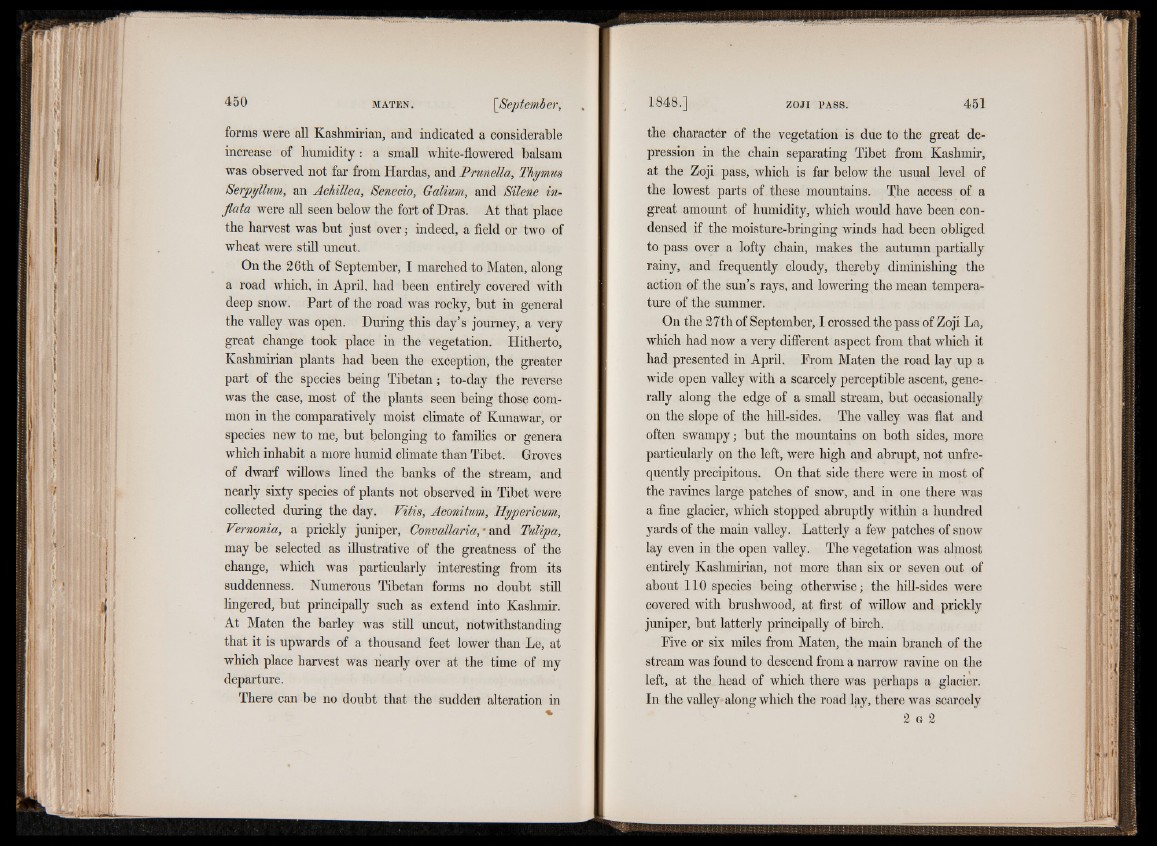
forms were all Kashmirian, and indicated a considerable
increase of humidity : a small white-flowered balsam
was observed not far from Hardas, and Prunella, Thymus
Serpyllum, an Achillea, Senecio, Galium, and Silene in-
fiata were all seen below the fort of Dras. At that place
the harvest was but just over; indeed, a field or two of
wheat were still uncut.
On the 26th of September, I marched to Maten, along
a road which, in April, had been entirely covered with
deep snow. Part of the road was rocky, but in general
the valley was open. During this day’s journey, a very
great change took place in the vegetation. Hitherto,
Kashmirian plants had been the exception, the greater
part of the species being Tibetan < to-day the reverse
was the case, most of the plants seen being those common
in the comparatively moist climate of Kunawar, or
species new to me, but belonging to families or genera
which inhabit a more humid climate than Tibet. Groves
of dwarf willows lined the banks of the stream, and
nearly sixty species of plants not observed in Tibet were
collected during the day. Vitis, Aconitum, Hypericum,
Vernonia, a prickly juniper, Convallaria, - and Tulipa,
may be selected as illustrative of the greatness of the
change, which was particularly interesting from its
suddenness. Numerous Tibetan forms no doubt still
lingered, but principally such as extend into Kashmir.
At Maten the barley was still uncut, notwithstanding
that it is upwards of a thousand feet lower than Le, at
which place harvest was nearly over at the time of my
departure.
There can be no doubt that the sudden alteration in
the character of the vegetation is due to the great depression
in the chain separating Tibet from Kashmir,
at the Zoji pass, which is far below the usual level of
the lowest parts of these mountains. The access of a
great amount of humidity, which would have been condensed
if the moisture-bringing winds had been obliged
to pass over a lofty chain, makes the autumn partially
rainy, and frequently cloudy, thereby diminishing the
action of the sun’s rays, and lowering the mean temperature
of the summer.
On the 27th of September, I crossed the pass of Zoji La,
which had now a very different aspect from that which it
had presented in April. From Maten the road lay up a
wide open valley with a scarcely perceptible ascent, generally
along the edge of a small stream, but occasionally
on the slope of the hill-sides. The valley was flat and
often swampy; but the mountains on both sides, more
particularly on the left, were high and abrupt, not unfre-
quently precipitous. On that side there were in most of
the ravines large patches of snow, and in one there was
a fine glacier, which stopped abruptly within a hundred
yards of the main valley. Latterly a few patches of snow
lay even in the open valley. The vegetation was almost
entirely Kashmirian, not more than six or seven out of
about 110 species being otherwise; the hill-sides were
covered with brushwood, at first of willow and prickly
juniper, but latterly principally of birch.
Five or six miles from Maten, the main branch of the
stream was found to descend from a narrow ravine on the
left, at the. head of which there was perhaps a glacier.
In the valley along which the road lay, there was scarcely
2 g 2